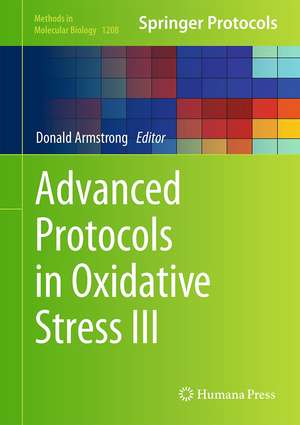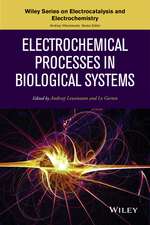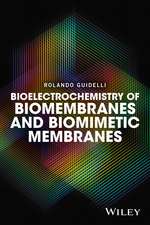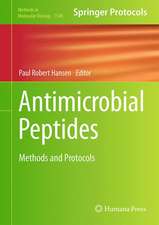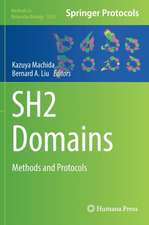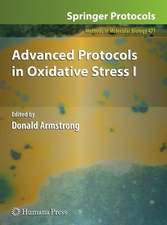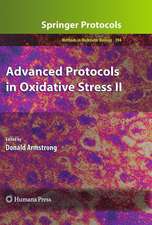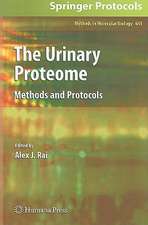Advanced Protocols in Oxidative Stress III: Methods in Molecular Biology, cartea 1208
Editat de Donald Armstrongen Limba Engleză Hardback – 20 oct 2014
Comprehensive and practical, Advanced Protocols in Oxidative Stress III offers to save investigators significant time and effort, allowing them to focus on their own personal topic of interest.
| Toate formatele și edițiile | Preț | Express |
|---|---|---|
| Paperback (1) | 712.22 lei 6-8 săpt. | |
| Springer – 22 sep 2016 | 712.22 lei 6-8 săpt. | |
| Hardback (1) | 966.90 lei 6-8 săpt. | |
| Springer – 20 oct 2014 | 966.90 lei 6-8 săpt. |
Din seria Methods in Molecular Biology
- 9%
 Preț: 791.59 lei
Preț: 791.59 lei - 23%
 Preț: 598.56 lei
Preț: 598.56 lei -
 Preț: 496.79 lei
Preț: 496.79 lei - 20%
 Preț: 882.95 lei
Preț: 882.95 lei -
 Preț: 252.04 lei
Preț: 252.04 lei - 5%
 Preț: 729.61 lei
Preț: 729.61 lei - 5%
 Preț: 731.43 lei
Preț: 731.43 lei - 5%
 Preț: 741.30 lei
Preț: 741.30 lei - 5%
 Preț: 747.16 lei
Preț: 747.16 lei - 15%
 Preț: 663.45 lei
Preț: 663.45 lei - 18%
 Preț: 1025.34 lei
Preț: 1025.34 lei - 5%
 Preț: 734.57 lei
Preț: 734.57 lei - 18%
 Preț: 914.20 lei
Preț: 914.20 lei - 15%
 Preț: 664.61 lei
Preț: 664.61 lei - 15%
 Preț: 654.12 lei
Preț: 654.12 lei - 18%
 Preț: 1414.74 lei
Preț: 1414.74 lei - 5%
 Preț: 742.60 lei
Preț: 742.60 lei - 20%
 Preț: 821.63 lei
Preț: 821.63 lei - 18%
 Preț: 972.30 lei
Preț: 972.30 lei - 15%
 Preț: 660.49 lei
Preț: 660.49 lei - 5%
 Preț: 738.41 lei
Preț: 738.41 lei - 18%
 Preț: 984.92 lei
Preț: 984.92 lei - 5%
 Preț: 733.29 lei
Preț: 733.29 lei -
 Preț: 392.58 lei
Preț: 392.58 lei - 5%
 Preț: 746.26 lei
Preț: 746.26 lei - 18%
 Preț: 962.66 lei
Preț: 962.66 lei - 23%
 Preț: 860.21 lei
Preț: 860.21 lei - 15%
 Preț: 652.64 lei
Preț: 652.64 lei - 5%
 Preț: 1055.50 lei
Preț: 1055.50 lei - 23%
 Preț: 883.85 lei
Preț: 883.85 lei -
 Preț: 792.16 lei
Preț: 792.16 lei -
 Preț: 423.62 lei
Preț: 423.62 lei - 5%
 Preț: 425.91 lei
Preț: 425.91 lei -
 Preț: 592.20 lei
Preț: 592.20 lei - 5%
 Preț: 345.62 lei
Preț: 345.62 lei - 19%
 Preț: 491.88 lei
Preț: 491.88 lei - 5%
 Preț: 1038.84 lei
Preț: 1038.84 lei - 5%
 Preț: 524.15 lei
Preț: 524.15 lei - 18%
 Preț: 2122.34 lei
Preț: 2122.34 lei - 5%
 Preț: 1299.23 lei
Preț: 1299.23 lei -
 Preț: 789.93 lei
Preț: 789.93 lei - 5%
 Preț: 1339.10 lei
Preț: 1339.10 lei - 18%
 Preț: 1390.26 lei
Preț: 1390.26 lei - 5%
 Preț: 752.66 lei
Preț: 752.66 lei - 5%
 Preț: 374.89 lei
Preț: 374.89 lei - 18%
 Preț: 1395.63 lei
Preț: 1395.63 lei - 18%
 Preț: 1129.65 lei
Preț: 1129.65 lei - 18%
 Preț: 1408.26 lei
Preț: 1408.26 lei - 18%
 Preț: 1124.92 lei
Preț: 1124.92 lei - 18%
 Preț: 966.27 lei
Preț: 966.27 lei
Preț: 966.90 lei
Preț vechi: 1179.15 lei
-18% Nou
Puncte Express: 1450
Preț estimativ în valută:
185.05€ • 192.68$ • 156.38£
185.05€ • 192.68$ • 156.38£
Carte tipărită la comandă
Livrare economică 08-22 martie
Preluare comenzi: 021 569.72.76
Specificații
ISBN-13: 9781493914401
ISBN-10: 1493914405
Pagini: 492
Ilustrații: XIV, 477 p. 146 illus., 64 illus. in color.
Dimensiuni: 178 x 254 x 32 mm
Greutate: 1.06 kg
Ediția:2015
Editura: Springer
Colecția Humana
Seria Methods in Molecular Biology
Locul publicării:New York, NY, United States
ISBN-10: 1493914405
Pagini: 492
Ilustrații: XIV, 477 p. 146 illus., 64 illus. in color.
Dimensiuni: 178 x 254 x 32 mm
Greutate: 1.06 kg
Ediția:2015
Editura: Springer
Colecția Humana
Seria Methods in Molecular Biology
Locul publicării:New York, NY, United States
Public țintă
Professional/practitionerCuprins
Derivatization and Detection of Small Aliphatic and Lipid-Bound Carbonylated Lipid Peroxidation Products by ESI-MS.- Specific Imaging and Tracking of Mitochondria in Live Cells by a Photostable AIE Luminogen.- Analysis of Relationship Between Oxidized Phospholipid Structure and Interaction with the Class B Scavenger Receptors.- A Novel Gas Chromatographic Method for Determination of Malondialdehyde from Oxidized DNA.- Nitric Oxide Availability as a Marker of Oxidative Stress.- Quantification of DNA Repair Capacity Towards Oxidatively Damaged DNA in Subcellular and Cellular Systems by a Non-Radioactive Cleavage Assay.- Chiral Phase-HPLC Separation of Hydroperoxyoctadecenoic Acids and Their Biosynthesis by Fatty Acid Dioxygenases.- Selenium as a Versatile Center in Fluorescence Probe for the Redox Cycle Between HClO Oxidative Stress and H2S Repair.- Evaluation of Physical Integrity of Lipid Bilayer Under Oxidative Stress: Application of Fluorescence Microscopy and Digital Image Processing.- Electrochemical Detection of Glutathione S-Transferase: An Important Enzyme in the Cell Protective Mechanism Against Oxidative Stress.- Using Nanosensors for In Situ Monitoring and Measurement of Nitric Oxide and Peroxynitrite in a Single Cell.- Curcuma longa Attenuates Carbon Tetrachloride-Induced Oxidative Stress in T Lymphocyte Subpopulations.- Prolongation of the Lag Time Preceding Peroxidation of Serum Lipids: A Measure of Antioxidant Capacity.- Identification of (Anti-Oxidative) Plants in Herbal Pharmaceutical Preparations and Dietary Supplements.- Simultaneous Determination of Ascorbic Acid, Aminothiols and Methionine in Biological Matrices Using Ion-Pairing RP-HPLC Coupled with Electrochemical Detector.- Portable Nanoparticle Based Sensors for Antioxidant Analysis.- Fe3+-Fe2+ Transformation Method: An Important Antioxidant Assay.- Antioxidant Activity Evaluation Involving Hemoglobin-Related Free Radical Reactivity.-Computational Studies on Conformation, Electron Density Distributions, and Antioxidant Properties of Anthocyanidins.- Automatic Flow Injection Analysis (FIA) Determination of Total Reducing Capacity in Serum and Urine Samples.- Mass Spectrometry Detection of Isolevuglandin Adduction to Specific Protein Residues.- Preoxiredoxin Family Members (Prx3 & Prx4) and Pregnancy Disorder (Recurrent Pregnancy Loss).- Substituted Pyridoindoles as Biological Antioxidants: Drug Design, Chemical Synthesis, and Biological Activity.- Measuring Antioxidant and Prooxidant Capacity Using the Crocin Bleaching Assay (CBA).- Simultaneous Determination of the Endogenous Free α−Lipoic Acid and Dihydrolipoic Acid in Human Plasma and Erythrocytes by RP−HPLC Coupled with Electrochemical Detector.- Aryl-Acetic and Cinnamic Acids as Lipoxygenase Inhibitors with Antioxidant, Anti-Inflammatory, and Anti-Cancer Activity.- Liquid Chromatography and Mass Spectrometry for the Analysis of N-β-Methylamino-L-Alanine with 6-Aminoquinolyl-N-Hydroxysuccinimidyl Carbamate.- Intracellular Distribution of Glutathionylated Proteins in Cultured Dermal Fibroblasts by Immunofluorescence.- New Analytical Strategies Applied to the Determination of Coenzyme Q10 in Biological Matrix.- Binding and Cytotoxic Trafficking of Cholesterol Hydroperoxides by Sterol Carrier Protein-2.- A Toolkit for Clinical Statisticians to Fix Problems Based on Biomarker Measurements Subject to Instrumental Limitations: From Repeated Measurement Techniques to a Hybrid Pooled-Unpooled Design.
Textul de pe ultima copertă
Advanced Protocols in Oxidative Stress III continues the thread of the first two books by covering technology ranging from a portable hand-held detector for remote analysis of antioxidant capacity to sophisticated technology such as shotgun lipidomics, mitochondrial imaging, nanosensors, fluorescent probes, chromatographic fingerprints, computational models, and biostatistical applications. Several chapters have shown the effect of pro-oxidation and antioxidants as inflammatory mediators in signaling pathways leading from the initial stimulus to termination through redox cycles. Written for the highly successful Methods in Molecular Biology series, chapters include introductions to their respective topics, lists of the necessary materials and reagents, step-by-step, readily reproducible laboratory protocols, and tips on troubleshooting and avoiding known pitfalls.
Comprehensive and practical, Advanced Protocols in Oxidative Stress III offers to save investigators significant time and effort, allowing them to focus on their own personal topic of interest.
Comprehensive and practical, Advanced Protocols in Oxidative Stress III offers to save investigators significant time and effort, allowing them to focus on their own personal topic of interest.
Caracteristici
Includes cutting-edge, all new methods and protocols in oxidative stress research Provides step-by-step detail essential for reproducible results Contains key notes and implementation advice from the experts Includes supplementary material: sn.pub/extras
